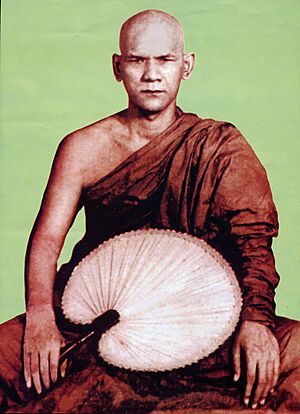Mahasi Sayadaw facts for kids
Quick facts for kids Mahasi Sayadaw U Sobhanaမဟာစည်ဆရာတော် ဦးသောဘန |
|
|---|---|

The Venerable Mahasi Sayadaw
|
|
| Religion | Buddhism |
| School | Theravada |
| Lineage | Mahasi |
| Education | Dhammācariya (1941) |
| Dharma names | Sobhana သောဘန |
| Personal | |
| Nationality | Burmese |
| Born | Maung Thwin 29 July 1904 Seikkhun, Shwebo District, British Burma |
| Died | 14 August 1982 (aged 78) Rangoon, Burma |
| Senior posting | |
| Based in | Mahasi Monastery, Yangon, Myanmar |
| Title | Sayadaw |
| Predecessor | U Nārada |
| Successor | U Pandita, Dipa Ma |
Mahasi Sayadaw U Sobhana (Burmese: မဟာစည်ဆရာတော် ဦးသောဘန; 29 July 1904 – 14 August 1982) was a famous Burmese Theravada Buddhist monk. He was also a respected meditation teacher. He greatly influenced how vipassanā (insight) meditation was taught around the world. Many people in the West and Asia learned from his methods.
His way of practicing meditation came from the New Burmese Method developed by U Nārada. Before meditating, people would first live by Buddhist rules of good behavior. The meditation itself focused on "bare insight." This means paying close attention to the body and mind. Meditators would notice the feeling of their stomach rising and falling with each breath. They would also carefully observe any other feelings or thoughts that came up. This practice helps people understand important Buddhist ideas like anicca (everything changes), dukkha (suffering), and anattā (no permanent self).
Mahasi Sayadaw was also a key person at the Sixth Buddhist Council. This was a big meeting of Buddhist leaders held on May 17, 1954. He helped review and edit the Buddhist scriptures.
Contents
Life Story of Mahasi Sayadaw
Early Life and Becoming a Monk
Mahasi Sayadaw was born in 1904 in a village called Seikkhun in Upper Burma. When he was twelve years old, he became a novice monk. At the age of twenty, he was fully ordained as a monk and was given the name Sobhana.
He spent many years studying Buddhist texts very deeply. He passed tough government exams on the Theravada Buddhist scriptures. In 1941, he earned a special degree called Dhammācariya. This means he was recognized as a master teacher of the dhamma, or Buddhist teachings.
Learning and Teaching Meditation
In 1931, U Sobhana took a break from teaching scriptures. He went to a nearby town called Thaton. There, he learned intense Vipassana meditation from a teacher named Mingun Jetawun Sayadaw, also known as U Nārada. This teacher had learned from other famous meditation masters.
U Sobhana first started teaching Vipassana meditation in his home village in 1938. The monastery where he taught was known for its very large drum, called 'Mahasi'. Because of this, he became known as Mahasi Sayadaw.
Spreading Meditation Centers
After World War II, in 1947, the Prime Minister of Burma, U Nu, invited Mahasi Sayadaw to Yangon. The Prime Minister wanted him to be the main teacher at a new meditation center. This center later became known as the Mahasi Sasana Yeiktha.
Mahasi Sayadaw played an important role at the Sixth Buddhist Council in 1954. He helped make sure the Buddhist scriptures were correct. He also helped set up many meditation centers. These centers were built all over Burma and in other countries like Sri Lanka, Indonesia, and Thailand. By 1972, more than 700,000 people had learned meditation at centers guided by him.
In 1979, he traveled to Western countries. He led meditation retreats at new centers, like the Insight Meditation Society in the U.S. Many people from all over the world also came to his center in Yangon to practice. Mahasi Sayadaw passed away on August 14, 1982, after a serious stroke. Thousands of his followers came to pay their respects, even during heavy monsoon rains.
How Mahasi Sayadaw Taught Meditation
Mahasi Sayadaw's meditation method is based on an ancient Buddhist teaching called the Satipatthana Sutta. This teaching explains how to focus your attention on your breath and other experiences.
Starting Your Practice
The first step in this practice is to live by sīla, which means practicing good morality. This involves letting go of worldly thoughts and desires. It's about being kind and honest.
Mindfulness of Breathing
After that, the meditator begins satipatthana, which is mindfulness practice. A key part is focusing on your breathing. You pay close attention to how you breathe in and out. As you do this, you notice any thoughts or feelings that come up. You simply "note" or "name" them in your mind, like "breathing, breathing" or "thinking, thinking." You don't get caught up in the thoughts, you just observe them.
By noticing these things, meditators become aware of how their senses connect with the world. This practice helps them gain insight into three important Buddhist ideas:
- Anicca: This means that everything is impermanent and always changing.
- Dukkha: This refers to suffering or dissatisfaction, which comes from wanting things to be permanent when they are not.
- Anatta: This means there is no fixed, unchanging "self" or soul.
When meditators truly understand these three ideas, their ability to notice things quickly improves. They can observe phenomena without needing to name them.
Well-Known Students
Mahasi Sayadaw taught many students who later became important teachers themselves. Some of them include:
- Ashin Silanandabivamsa
- Sadhammaransi Sayadaw
- Sayādaw U Paṇḍita
- Chanmyay Sayādaw (U Janakabhivamsa)
- Achan Sobin S. Namto
- Nyanaponika Thera
- Anagarika Munindra
- Dipa Ma
- Ashin Jinarakkhita
- Joseph Goldstein
- Sharon Salzberg
- Jack Kornfield
- Freda Bedi
- G. V. Desani
- Pa-Auk Sayadaw

